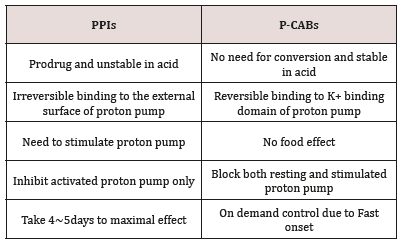Lupine Publishers | Current Trends in Gastroenterology and Hepatology
Over the past several decades, great progress has been made on
understanding mechanisms of gastric acid secretion for
developing new anti-acid drugs. Until now most commonly used anti-acid
drugs are histamine-2 receptor antagonists and proton
pump inhibitors (PPIs) for patients to control acid related disease.
However, several clinical limitations of these drugs had been
reported. Recently, a new generation of potassium-competitive acid
blockers (P-CABs) were launched for clinical use. It has been
shown that these new drugs are more convenient and powerful to treat
gastric acid-related diseases. In this article, we briefly
reviewed the clinical use of this new anti-acid drug P-CAB.
Keywords:Potassium-competitive Acid Blocker; Potassium channel; H+/K+-ATPase
Introduction
H+/K+-ATPase (or proton pump), which is expressed in gastric
parietal cells, is one of the potassium transporters acting in the
last stage involved in gastric acid production and secretion [1].
It functions in the parietal cells that pump out protons into the
luminal space of gastric glands to reach a level of one million-fold
enrichment of H+ in the gastric juice. At the same time the K+ is
absorbed into the cell, which is coupled with K+ recycling by
potassium channels [2,3]. The gastric H+/K+-ATPase has a half-life
of 50h, hence about 25% of proton pumps are newly synthesized
per day, at a rate of about 1% per hour [4]. The importance of K+
in the production of gastric acid makes its regulation a potential
target for treatment [5].
Discussion
Clinical Limitation of PPIS
Since proton pump inhibitors (PPI) were first discovered
in 1981, several types of PPIs have been used in the treatment
of acid–related diseases such as peptic ulcer disease (PUD),
gastroesophageal reflux disease (GERD) for the past 30 years [6,7].
PPIs bind irreversibly to the gastric H+/K+-ATPase and inhibit
potassium recycling, thus this inhibition is long-lasting and dose
not show rapid tolerance which allows acid rebound following
withdrawal that had also appeared in histamine-2 receptor
antagonists. However, they have short plasma half-life of about
2hrs and are rapidly degraded in vivo and bind only to activated
proton pump. Therefore, these drugs require daily dosing of 4
to 5 days to achieve the maximum efficacy [8]. There were many
cases in which they were unable to demonstrate sufficient effect
when the medication time was not properly maintained before a
meal. PPIs binding only to active form of proton pump have been
known clinically to be limited to increase the pH to only around
4.0. Meanwhile, it has been reported that increasing the pH to 6.0
instead of to 4.0 for Helicobacter pylori eradication is more effective
[9].
Novel P-CAB Class Drugs
Potassium-competitive acid blocker (P-CAB) reversibly inhibits
acid secretion by competing with the potassium ion on the luminal
surface of the gastric wall H+/K+-ATPase. The first developed
compound was SCH28080 in 1982 [10]. Animal and early clinical
studies have shown that P-CAB is highly selective for gastric H+/K+-
ATPase and inhibits gastric acid secretion with fast onset of action
[11]. SCH28080 has been used extensively to reveal the mechanism
of proton pump inhibition. However, the first-generation drugs did
not come out due to its brief action time and hepatotoxicity [12].
The new generation of P-CAB drugs, Vonoprazan (TAK-438) and
Tegoprazan (CJ-12420) that overcome these shortcomings were
recently launched [13,14]. These drugs block not only the proton
pump in the active form but also the inactive form proton pump,
thereby effectively increasing intraluminal pH to 6.0. In the case of
vonoprazan, 98% of H. pylori eradication treatment results were
reported [15]. The comparisons between PPI and P-CAB products
are shown below in the Table 1.
Table 1: The differences between PPIs and P-CABs.

Conclusion
Advantages of P-CAB versus PPI include the rapidly and more
potent acid suppression, stable in acid condition, meal independent,
able to elevate pH to 6.0 and better treatment of PUD, GERD, and H.
pylori eradication. It is predicted that P-CAB drugs will be widely
used as next generation drugs overcoming the shortcomings of
existing PPI drugs.
ollow on Linkedin : https://www.linkedin.com/company/lupinepublishers
Follow on Twitter : https://twitter.com/lupine_online
Comments
Post a Comment